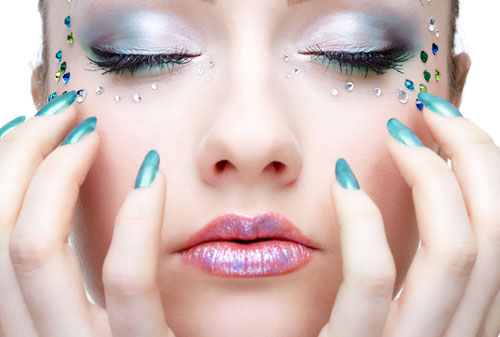What we call "shelf life of cosmetics" is not exactly what we are used to seeing on other products. For example, on food products there is clear information: "Ready until ..." or "Shelf life ..." . For cosmetics, there are two indicators for the shelf life of cosmetics.
Deadline cosmetics shelf life was of interest to customers only recently, about 15 years ago, when trust in the quality of cosmetics was undermined. More and more often buyers began to complain that just purchased cosmetics and smells bad, too watery or there are various suspicious lumps in it. Trust is the main indicator of any trade.
Therefore, when there are ideas of new products, such as paired T-shirts, you need to carefully lead the buyer to the fact that such T-shirts are necessary for the buyer. However, the idea of selling paired T-shirts, that is, identical in style and pattern T-shirts for lovers, will certainly occupy its niche and will very soon become a hit in sales.
Shelf life of cosmetics
But let's get back to the shelf life of cosmetics. The simplest and most straightforward designation is an icon with an open jar, on or next to which there are one or two numbers with the letter M. These numbers mean that the product, once opened, can be used for a certain amount of time. For example, 3M means that once the product is opened, it can be used for 3 months. 6M means for 6 months. However, this designation cannot be fully called a shelf-life determination. It is called the Period-after-opening (PAO) symbol or the symbol that defines the period of use after opening the cosmetic.
Date of manufacture
The second indicator is to determine the date of manufacture of the cosmetics. Cosmetics, like every food product, have a special designation called batch code/batch number, which can be translated as "code or batch (of a product); series (of a product). Not to be confused with the barcode, check here: https://www.labeltest.com/scodes.html. That's different.
In cosmetics, unlike the uniformity of product barcodes, there is no single rule for coding a series or batch of products. Each cosmetics manufacturer has its own designations. However, each code must necessarily include the year, month or day of manufacture of a particular batch of goods. Along with this information, manufacturers may include the serial numbers of the batch, the shift number when that cosmetic was produced, the country where the cosmetic was made, the factory where it was manufactured. Some manufacturers include the date when the type of cosmetic in question was put into production, as well as designating when a particular product code first appeared.
The product code is intended if a particular cosmetic is to be withdrawn from sale in case of product deterioration or toxicity or for some other reason. So that the entire line of cosmetics is not withdrawn, but just a part. For example, in 2007 a batch of Russian shampoo "Antisedin" of the brand "Two Lines" was withdrawn from sale in the EU with batch number: 03; bar code: 4607082850019, as this cosmetic contained an unacceptably high percentage of lead.
For buyers, the product code is also very important to know when exactly the cosmetics were manufactured. Based on this, it is easy to determine whether the shelf life of the packaged cosmetics of each particular brand has expired. This is due to the fact that each cosmetics manufacturer has its own shelf life for packaged products. For example, Avon brand products can be stored for 3 years. Some Mary Key cosmetics, such as Acne Treatment Gel, TimeWise Day Solution With Sunscreen SPF 25, Sunless Tanning Lotion has a shelf life of only 2 years. Recently, the average shelf life for unopened cosmetics in EU countries has been determined to be no more than 30 months.
That is, by determining the date of manufacture from the batch code, we can accurately calculate whether we are buying cosmetics that are known to be expired. Product codes are usually located on labels in the form of printed numbers or letters, or numbers and letters together, or on the packaging itself in the form of pressed numbers and letters. They may include two or more characters.
Mary Key brand cosmetics code is designated as follows: Crystalline #882800 FX05. The first 6 digits are a batch of goods, so from the point of view of determining the expiration date these digits are not interesting for us. We should pay attention to the alphanumeric designation of the second part of the code - FX05. The first letter denotes the year, the second - the month, the third - the date of manufacture of this cosmetic. Having deciphered these designations, we learn that this product was manufactured on December 5, 2004. If we bought it in 2009, i.e. 4 years ago, we can be sure that the expiration date of this product is expired.
Unfortunately, information about codes, batches and series is not disclosed by the manufacturing companies. The only company that has openly published the decoding of its designations is Burt's Bees.
However, these are not all the main parameters that you should pay attention to when choosing cosmetics. Fake cosmetics can be easily identified by the bar code. In the program at www.labeltest.com, 13 digits are entered under the barcode. As a result, you can find out the country of manufacture and determine the authenticity of the barcode.
There is one trick that allows you to almost immediately determine the manufacturing date of cosmetics. Look at its composition. After 2009, according to EU rules, fragrances in the composition of cosmetics should not be labeled with one word - Parfum or Fragrance. To these words are added chemical names of fragrances such as linalool, geraniol, limonene, etc. If these substances are in the list of cosmetics composition, it means that such cosmetics were produced after 2009. Ingrown hairs in men.






